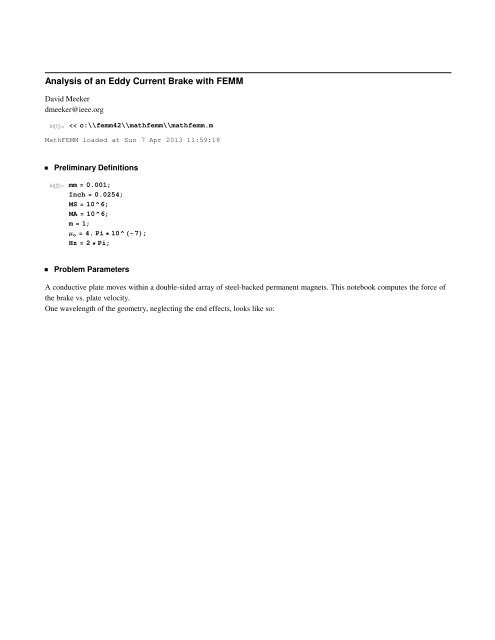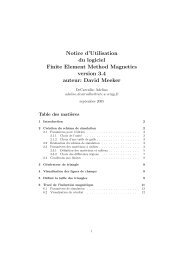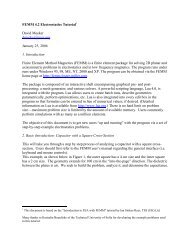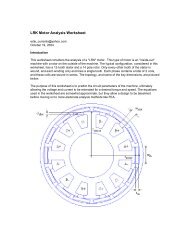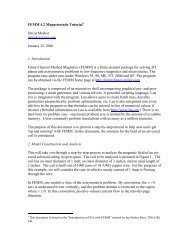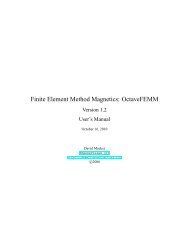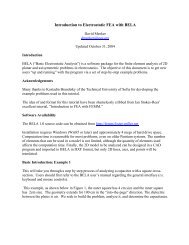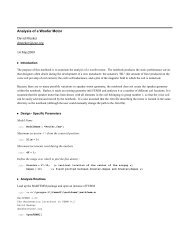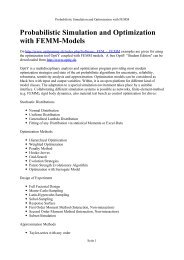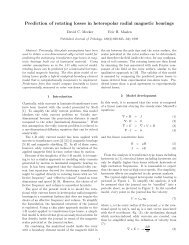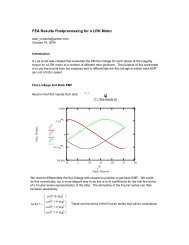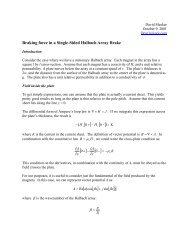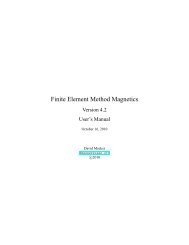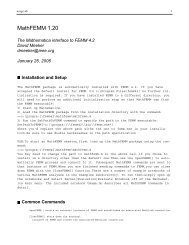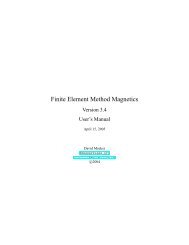Analysis of an Eddy Current Brake with FEMM
Analysis of an Eddy Current Brake with FEMM
Analysis of an Eddy Current Brake with FEMM
Create successful ePaper yourself
Turn your PDF publications into a flip-book with our unique Google optimized e-Paper software.
<strong>Analysis</strong> <strong>of</strong> <strong>an</strong> <strong>Eddy</strong> <strong>Current</strong> <strong>Brake</strong> <strong>with</strong> <strong>FEMM</strong><br />
David Meeker<br />
dmeeker@ieee.org<br />
In[1]:=
2 eddycurrentbrake.nb<br />
In[9]:= BHmax = 40; H∗ Energy product <strong>of</strong> the magnet in MGOe ∗L<br />
pp = 25 ∗mm; H∗ Pole pitch <strong>of</strong> the magnets ∗L<br />
wm = 20 ∗mm; H∗ Magnet width ∗L<br />
tm = 5 ∗mm; H∗ Magnet thickness ∗L<br />
tb = 5 ∗mm; H∗ Back iron thickness ∗L<br />
tp = 2.5 ∗mm; H∗ Conductive plate half−thickness ∗L<br />
g = 1 ∗mm; H∗ Air gap length between magnet <strong>an</strong>d plate ∗L<br />
σ = 30;H∗ Plate conductivity in MSêm ∗L<br />
h = 100 ∗mm; H∗ Depth <strong>of</strong> magnet array ∗L<br />
ε = 20 ∗mm; H∗ Plate overh<strong>an</strong>g on either side <strong>of</strong> the magnets ∗L<br />
ü Derived Qu<strong>an</strong>tities<br />
Mech<strong>an</strong>ical frequency <strong>of</strong> the magnet array<br />
In[19]:= β = π êpp;
A big problem <strong>with</strong> using a 2D solver to <strong>an</strong>alyze this sort <strong>of</strong> machine is that 3D tr<strong>an</strong>sverse edge effects c<strong>an</strong> signific<strong>an</strong>tly influence<br />
the perform<strong>an</strong>ce <strong>of</strong> the brake. Fringing near the tr<strong>an</strong>sverse edge me<strong>an</strong>s that some <strong>of</strong> the PM flux doesn't link the plate, lessening<br />
the maximum force produced by the brake. The resist<strong>an</strong>ce <strong>of</strong> the edge <strong>of</strong> the plate, where the currents "turn around", makes the<br />
plate look more resistive <strong>an</strong>d pushes out the speed at which the peak force occurs. Here, we will put in some kludgy corrections<br />
to account for these effects.<br />
The total stack-up <strong>of</strong> unit permeability materials between plate centerline <strong>an</strong>d iron is gtot:<br />
In[20]:= gtot = Htp +g+tmL;<br />
Use this dist<strong>an</strong>ce to get <strong>an</strong> appoximate derating to account for fringing at the tr<strong>an</strong>sverse edges. This is <strong>an</strong> approximate kludge that<br />
is probably no good for <strong>an</strong> array that isn't wide compared to gtot. Say that the width <strong>of</strong> a fringing region is hf:<br />
In[21]:= hf = gtot ê2;<br />
Shorten the active region by a bit, snipping <strong>of</strong>f the fringing region <strong>of</strong> width hf on each side <strong>of</strong> the stator:<br />
In[22]:= heff = h −2∗hf;<br />
Add the width <strong>of</strong> the fringing region to the width <strong>of</strong> the "end turn" region <strong>of</strong> the plate<br />
In[23]:= εeff = ε +hf;<br />
Correct the conductivity to account for the tr<strong>an</strong>sverse edges <strong>of</strong> the plate<br />
In[24]:= σeff = σ ë I1 +2ëIβ 2 ∗heff ∗ εeffMM<br />
Out[24]= 28.3801<br />
Rem<strong>an</strong>ence <strong>of</strong> the PMs in Tesla (see http : // www.femm.info/Archives/misc/BarMagnet.pdf)<br />
In[25]:= Br = Sqrt@BHmaxD ê5.<br />
Out[25]= 1.26491<br />
Coercivity <strong>of</strong> the PMs in A/m<br />
In[26]:= Hc = Br ê µo<br />
Out[26]= 1.00658 ×10 6<br />
eddycurrentbrake.nb 3<br />
You c<strong>an</strong> replace a perm<strong>an</strong>ent magnet by <strong>an</strong> equivalent current sheet that produces the same external fields. For this particular<br />
case, the equivalent current sheet representation looks like:
4 eddycurrentbrake.nb<br />
We w<strong>an</strong>t to replace the current sheet by a sinusoidally distributed b<strong>an</strong>d <strong>of</strong> current density. Most <strong>of</strong> the force in <strong>an</strong> eddy current<br />
brake is due to the fundamental, <strong>an</strong>d if we just consider the fundamental, we c<strong>an</strong> make a simulation in <strong>FEMM</strong> that includes<br />
"motion".<br />
Find amplitude <strong>of</strong> the fundamental in a Fourier Series (http://en.wikipedia.org/wiki/Fourier_series) representation <strong>of</strong> the equivalent<br />
current density <strong>of</strong> the PMs in units <strong>of</strong> A/m^2.<br />
There is a + current sheet <strong>of</strong> strenght Hc located at (pp-wm)/2 <strong>an</strong>d a - current sheet located at (pp+wm)/2. The result is in units<br />
<strong>of</strong> A/m^2<br />
In[27]:= Jmag = HHc ∗Cos@β ∗ Hpp −wmL ê2D − Hc ∗Cos@β ∗ Hpp +wmL ê2DL êIntegrate@Cos@βxD^2, 8x, 0, pp
In[33]:= MIDrawRect<strong>an</strong>gle@80, 0
6 eddycurrentbrake.nb<br />
In[62]:= MISelectSegment@80, tp +g+tm ê2
In[82]:= ListPlot@data, Joined → True, ImageSize → 500, Frame → True,<br />
GridLines → 8Table@k, 8k, 0, 25, 5
8 eddycurrentbrake.nb<br />
In[87]:= Show@ListPlot@data, PlotR<strong>an</strong>ge → AllD,<br />
Plot@Fbrake, 8v, 0, 2vopt1d


